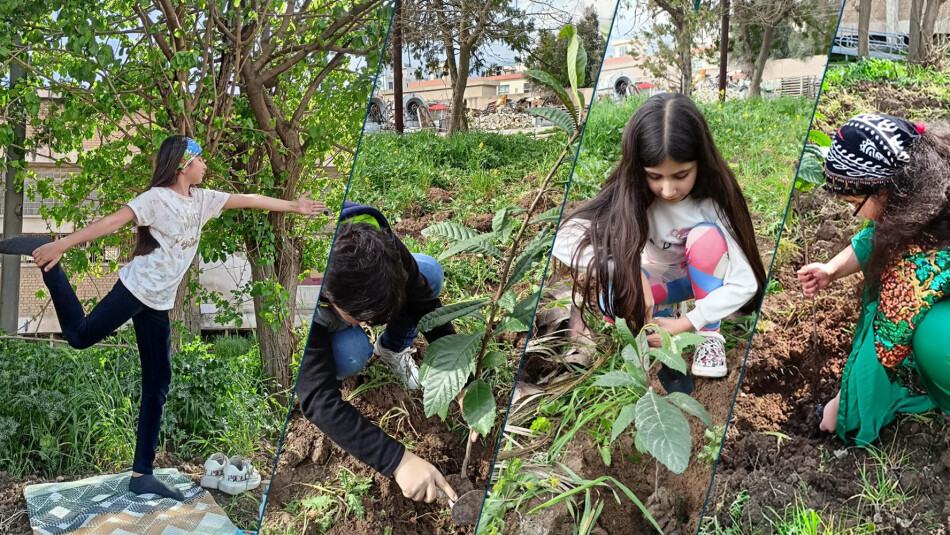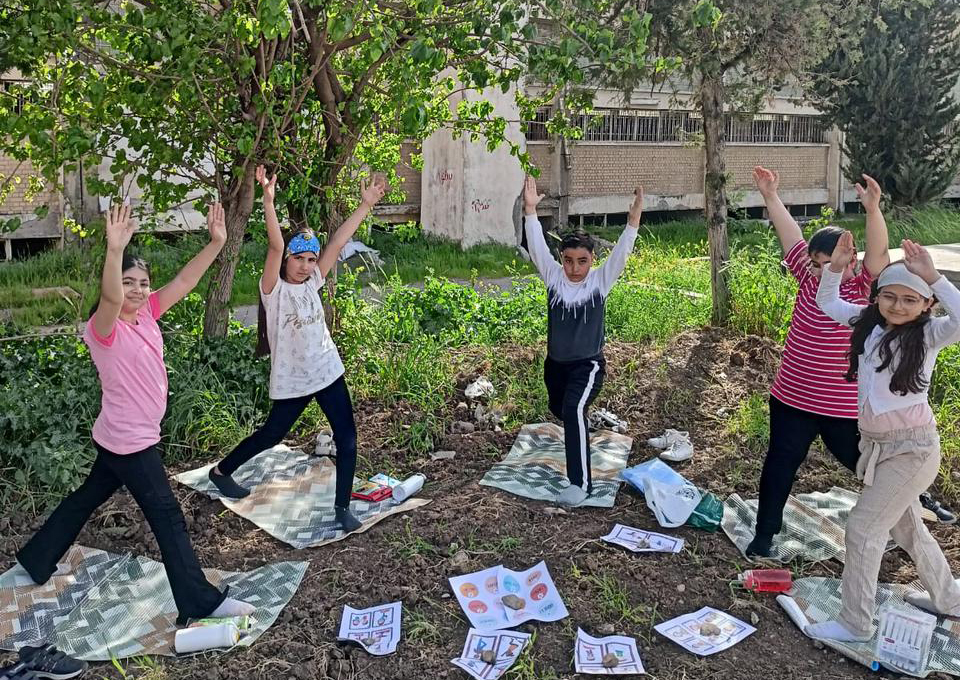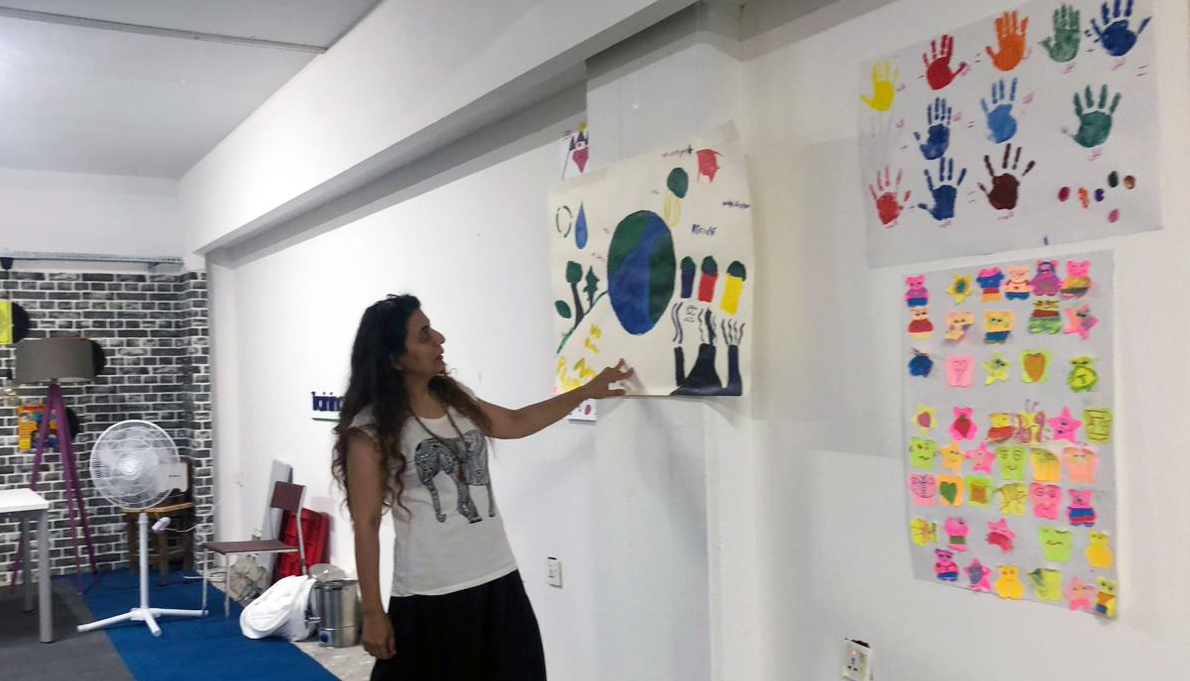
Elia is an eight-year-old girl. Since she joined the Yoga House, she planted a tree and named it after herself, so she loves it like herself and takes care of it. Not only that, she also learned not to throw plastic waste.
The Yoga House is an educational project that combines sports and interest in greening. Children are accepted into the house on the condition that they plant a tree, take care of it, and participate in the planting season activities, some of which are related to protecting the environment, including recycling plastic.
"Our main goal was to combine yoga with the environment," says Kazia Taher Siddiq, founder of the Yoga House in the Cultural Factory in Sulaymaniyah. "In yoga, the first thing a person is introduced to is cleanliness, starting with their personal clothes and reaching the environment around them, especially not throwing waste randomly, especially plastic waste."
The northern province of Sulaymaniyah produces more than 1,000 tons of waste daily, a percentage of which is plastic waste, but this percentage has not been determined, and this is part of the problem of dealing with and treating waste in the Kurdistan Region of Iraq KRI and all over Iraq, since large quantities of it are burned at a time when there is a direct relationship between air pollution and plastic waste.
According to (IQAir), a Swiss company working in the field of air quality technology, Iraq's air is among the "most polluted" in the world.
The primitive solution to combat air pollution is to plant trees and increase the percentage of green spaces, similar to the small initiative adopted by the Yoga House.
I tell them that we plant these trees so that we can practice yoga exercises in their shade
Back to nature
Siddiq, a lady in her thirties, graduated from the College of Fine Arts and teaches in her field at one of the schools in Sulaymaniyah. The idea of establishing the Yoga House came to her a long time ago, but she did not have the opportunity to implement her idea until March 2024.
“I teach children that happiness is linked to greenery, and we must contribute to producing this green environment,” says added.
The Yoga House receives children from the age of three to 14. In the first lesson of the season, the children are taken to a small garden in the Cultural Factory and each child is given a tree to plant in an area not exceeding 500 square meters.
“I tell them that we plant these trees so that we can practice yoga exercises in their shade,” so the children return to nature and learn this spiritual sport under the shade of the trees.

The children plant the trees with passion and smiles on their faces. Some of them are very young, and their teacher helps them in digging and planting. Each tree is named after the child who participated in planting it. One is called Ilya, another Launa, and so on.
“I did this so that the children would constantly think about taking care of their trees, cleaning the place and serving the environment,” Siddiq says. Her team planted 40 trees in a few months with the help of the gardener who works at the cultural factory and they take care of them daily.
There are no accurate and official figures about the percentage of green spaces in Sulaymaniyah, but it is estimated to be between 15 to 19%. A statistic announced by the Ministry of Agriculture in the Kurdistan Regional Government KRG in 2015 and approved by the Environmental Protection Authority indicates that the percentage of greenery in the region is 12%, while international standards set the percentage at 30%.
Majid Rahim (50 years old), a gardener who works at the Culture Factory once used to be a state cigarette plant in Sulaymaniyah, said, “The trees that the children planted were loquat fruit. They would come every day and receive lessons here, water the trees and take care of them.”
The children only planted loquat trees, which are fruitful and evergreen. They did not buy the trees from nurseries or anywhere else. The trees were produced at the Yoga House and were ready to be planted.
Another activity that takes place at the Yoga House is environmental protection, specifically collecting plastic waste for recycling. Children at the Cultural Factory had the opportunity to collect water bottles and take them to the Suli-Cycle, a machine that exchanges plastic for money, where the plastic is collected and the user is rewarded. The rewards come in the form of discounts at several locations inside and outside Sulaymaniyah.
“When we go to nature, we clean up our surroundings and we have special campaigns every week,” the yoga trainer said, pointing to some of the artwork made from fallen leaves that they collect during the campaigns.

Children Build a Green Future
Anna and Launa, two girls who joined the Yoga House, are close friends who named their trees after themselves. They used to compete every day to see whose tree would grow faster.
Kazia says that Anna felt sad because her tree didn’t grow as fast as her friend’s tree, but Launa told her that she didn’t have to be sad and that she was singing to her tree and telling it that she loved it and that Anna could do the same. After returning home, the children act as environmental protectors among their families.
Shanga Ali, the mother of a three-year-old girl, says, "All the activities, especially planting trees, have had an impact on her, because she has started digging and planting the seedlings herself and waiting for them to grow quickly. She has started to feel accountable."
Her daughter has also gotten used to collecting plastic waste and putting it in a special bag without mixing it with other waste, and then taking it with her father to the cultural factory. All the other children enrolled in the yoga house compete over who collects the largest amount of plastic waste to recycle.
The United Nations is constantly asking everyone for help to confront climate change, as Iraq is ranked fifth among the countries most affected by the repercussions of climate change.
Children who are taught to be environmentally friendly will never be environmentally hostile in the future
"People should get used to loving the environment from a young age. Children who are taught to be environmentally friendly will never be environmentally hostile in the future," according to Rangin Nouri, a psychologist who has been working in the field of child rearing for 14 years.
Nouri says that for a child to learn good habits, he or she needs practical lessons to cement the information in his head.
“The best way to do this is to use as many senses as possible: touch, sight and hearing. When the child names a tree after his, he will take care of it."
She praises giving children roles in such activities, so they will not forget them throughout their lives and they will become part of their behavior.
A short time and other difficulties
The Yoga Art Center and its environmental activities witness a large turnout in the summer during the school holidays, but their numbers decrease during other periods.
Siddiq started her project as a volunteer, but then decided to collect a small amount due to the addition of other activities and events, in addition to the staff's wages.
"The main problem is transportation. Previously, I used to take them to and from the center myself, but transportation has become a problem facing most children due to the inconsistency of attendance hours with school hours and the inability of their families to transport them."
Two of Paewast Aref's children were among those enrolled in the Yoga Center she admires. "They are like a candle in the dark. They have beautiful ideas that have had a positive impact on my children regarding the environment."
She expressed her regret for not being able to send her children to the Yoga Center since school began. "We no longer We live in Sulaymaniyah, and it is also the school season.”
Aref suggests that the Yoga House should move its activities to schools, which Siddiq supports. She decided to try her project in the school she attends, but the instructions of the Education Directorate did not help her achieve her goal.
In the absence of children, the gardener takes care of the trees, but he suffers from a lack of water. “If it weren’t for this problem, I would have turned the entire place into a green spot within two years.”
The Yoga House initiative is still in its early stages, and she has agreed with the Cultural Factory to continue planting trees by the children.